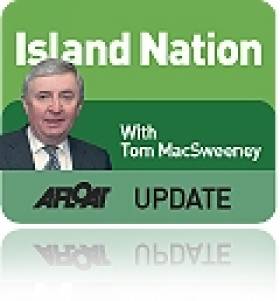Displaying items by tag: Bulman Buoy
#islandnation – Entering Kinsale Harbour, east of the Bulman Buoy, is a prominent 200-foot cliff rising sharply above the sea. It is known as Hangman Point and was the location of a gibbet, a warning to everyone not to engage in piracy. Displayed there in 1675 was the head of one of six Irishmen who had murdered the Master and three crew aboard what was described as "a very rich ship," the St.Peter of Hamburg which had been bound for France. This gang sailed the vessel to the West Coast of Ireland where they were captured by the authorities led by Robert Southwell, Vice Admiral of Munster. Convicted and executed, their heads were displayed at different points along the coast, including one at Hangman Point.
The next time I am rounding the Bulman heading for Kinsale I'll take more note of Hangman Point about which I hadn't known a lot, though I did know of the roadside reminder out towards the Old Head of Kinsale of the female pirate Anne Bonney, another story of piracy from the locality. She was actually Anne Cormac, described as "a vivacious girl" who lived with her father, William, in a fine house on the edge of Bullen's Bay which was a haven for piracy on the south coast not far from Kinsale, providing a place to land stolen goods and get water and provisions.
She shared the maritime activities of the area, but her father was actually a successful Cork lawyer who emigrated from that area to the Carolinas in America where the doughty daughter was drawn to the sea, despite the best efforts of her father to steer her in other directions. This led her to falling for the charms of pirate and buccaneer 'Calico' Jack Rackham who was terrorising the coast of Bermuda.
Anne took to the life of piracy, engaged in it by boarding ships and capturing and looting them and was regarded as a tough fighter. Despite pregnancies, she had her children fostered to continue her cutlass-bearing life. Captured eventually, both 'Calico' and Anne were sentenced to hang. Because she was again pregnant she was reprieved and her last words to 'Calico' before he faced the hangman, according to legend were: "If you had fought like a man, you would not now be hanged like a dog!"
I am not sure I would particularly like such a female type aboard, but out towards the Old Head of Kinsale there is a roadside plaque reminding passersby of Anne Bonney.
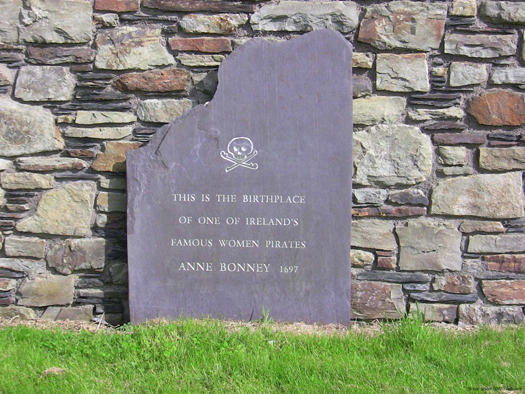
The story is told by John Thullier, well-known in the maritime world and in sailing after a lifetime involvement with boats. He is the retired Director of Kinsale Further Education College and steeped in the maritime tradition of the town. The College evolved from projects designed to introduce the maritime environment to students and providing training in marine skills.
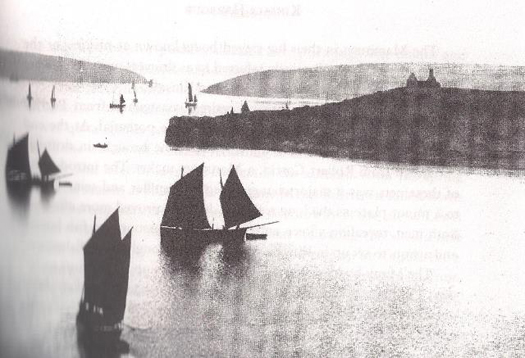
He has compiled the history of Kinsale Harbour and told me how, on walks around the seafront of the town with his grandfather who was a good boat builder timber needed would be spotted, with it all explained to him as a youngster about what a boat needed to be sturdy. John recalled to me how Sundays were the day of leisure, so the men would go sailing and, "in soft hat and with shirt and tie!" Those were times when there was a different approach to sailing clothing!
"Kinsale Harbour – A History," published by The Collins Press, was launched this week at Kinsale Yacht Club. In it John Thullier charts the history of a town now known best for its tourism and food, but which he says must retain its focus of being a port and a maritime location.
Nestling on the River Bandon as it sweeps to the sea, Kinsale emerged as a settlement in the 6th century and has seen many changes.
"Really there are three harbours here, the inner, the middle and the outer and Kinsale has changed over the years as it evolved to meet the many challenges," he said as we chatted overlooking the harbour from the front of the Trident Hotel where the statue of a fisherman, resting and thinking, reminds patrons that this too was once a big fishing port and still retains fishing boat activity.
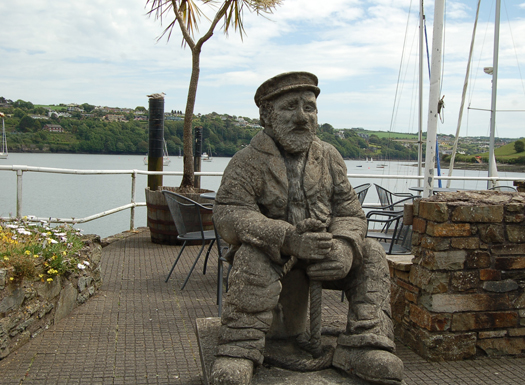
"The harbour has always provided a safe anchorage and prospered during the golden age of sail, victualling shops bound for the American colonies, the West Indies and trading with English and Continental ports. Many people will remember it for the Battle of Kinsale, but there is much more to the town and the maritime tradition is its main reason for existence. There was a Naval base to restrict threats of foreign invasion, there were pirates and smugglers, it was a shipping port, it evolved when the size of ships changed, it was a big fishing industry centre, that changed too as the industry and stocks moved. It still retains some fishing and it became a sea angling centre which gave it a new life.
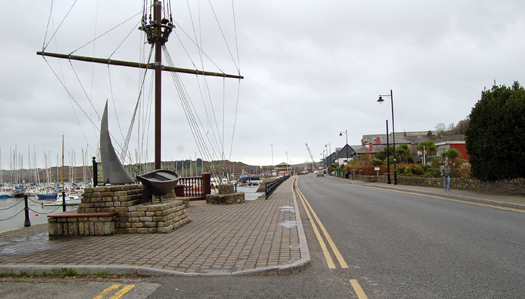
Now it is still very active in the marine, as a sailing centre. There have been difficult times here in Kinsale, but the way a town like this survives is to focus on what it has best, that is the maritime role, its maritime resources and facilities."
Even where we sat talking about Kinsale, where the Trident Hotel stands, he told me was once a dockyard.
"My mother's family was involved in the fishing industry, on my father's side the family were boatbuilders, owners and members of various boards and public bodies engaged in the affairs of the harbour.
"The story of Kinsale is the history of its connection with the sea. Everything about Kinsale is of the sea and so it should remain," says John Thullier, whose book about this major sailing location is well worth reading.
And if you want to know what happened to Anne the pirate, John Thullier says:
"No precise information is available about her after Rackham's hanging. There are reports that she abandoned piracy, was reconciled with her father, remarried and had eight more children."
I like a happy ending!
Twitter: @TomMacSweeney
Cork Institute of Technology Win 2010 Student Yachting Nationals
Last weekend saw the Student Yachting Nationals take place at the Royal Cork Yacht Club. The students had the use of the ISA J80 Sailfleet for the event. Six college teams entered for the Nationals which was the Qualifier for the Student Yachting World Cup 2011.
Racing was scheduled for Cuskinny on Friday and conditions were ideal with 17-20 knots of breeze. Race Officer, Nathan Kirwan, got in four good races lasting some 40 to 50 minutes each. However, spinnakers were banned as some wipeouts had been observed by the ISA Bosun who exercised his judgment in this regard. Some two minutes after the start of the first race UCC skippered by Robert O'Leary suffered a snapped halyard but were refused redress. CIT skippered by George Kenefick lost their only winch handle overboard some three minutes before the start in race 1 but still managed to win the race by a comfortable margin. In race 2 UCC came back strongly to take the gun and pushing CIT into second place. At this stage match racing had begun between the two Cork colleges with each throwing dummy tacks to try to clear their air. In Race 3 TCD skippered by Alistair Kissane took the win with CIT in second and UCC third. The final race of the day was won by CIT with UCC third. Overall standings for Day One were: CIT 6pts, with UCC and TCD on 12 pts each. UCD had got off to a shaky start which was to prove costly for them as they were on form on days two and three.
On day two the Race Officer moved the course to the Curlane Bank and spinnakers were permitted. CIT found their rythym taking the bullet in race 5 with UCD in second and a poor mark rounding relegated UCC to third place. Race 6 saw the O'Leary and Kenefick teams doing circles at the pre start as the competition was intensifying and it was looking like a two horse race. UCC took first place with NUIG taking second and CIT third. Donagh Good of CIT went for a quick dip in the cold water but managed to grab on and was pulled back on board by George Kenefick and Kevin Goulding. Later during day 2 the wind was rising to 22 knots so spinnakers were once again banned. UCC found the conditions very much to their liking, taking the win, with TCD in second, UCC third and CIT fourth. Race 8 proved to be rather interesting with CIT managing to relegate UCC to last position and managing to keep UCC in their sight for the duration of the race. Downwind was difficult for CIT with UCC right on their tail but UCC were not successful in finding a passing lane. Again, UCD took their second bullet of the day with CIT and UCC in fifth and sixth positions some four to five minutes behind the rest of the fleet. CIT were able to discard their fifth position but UCC were unlucky in having to count their sixth as they also had a sixth from day one. TCD again got a second position. Results after day two were: CIT 14pts, UCC 19pts, UCD and TCD on 21pts each.
Day 3 was a non discardable coastal race from Crosshaven to Kinsale counting for 1.5pts. The start line was just off Roches Point with five knots of breeze and brilliant sunshine. UCC led the fleet and NUIG and CIT were in last position 300 metres behind the rest of the fleet. As the race went on the wind increased to a nice south westerly breeze of 12 to 14 knots. As this stage it looked as if it might be UCC's lucky day but Team CIT maintained their composure and by tacking close to the shore and keeping out of the tide managed to finish in third position at the Bulman Buoy with UCC first and UCD second. This result was to prove sufficient to give CIT the national student title for 2010.
Overall Results:
CIT 18.5pts
UCC 20.5pts
UCD 24pts
TCD 28.4pts
NUIG 33pts
UL 40pts


























